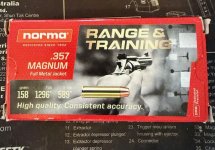fiasconva
US Veteran
That is a shame. Did it damage your hand or just the gun? Even if it's damaged beyond repair you can still sell some of the parts to members needing them. I hate to see something like that happen.
Last edited:
The K on the butt indicates K38.
There is a lot I don't know, the OP did not mention if he had hard extraction on the fired cases. All we know is his comment that it was a "hot round". Hot rounds do crack forcing cones. I would be curious to know if the cylinder is ringed in anyway. The fact the OP says the cylinder turns half way and sticks could be due to the "destroyed yoke" or an expanded cylinder.
You would think that FMJ would not create over pressures in a 38 Special by itself. If the round was over pressure, the most probable cause was too much powder in the case.
A 1952 S&W was made of softer steels (probably a plain carbon steel), and the steels of the period had more residuals and crud in them than good steels made today. Old steels are weaker and more prone to failure. Not knowing the pressures of the kaboom round, we don't know if a modern S&W would have survived this in any better condition.
It is most unfortunate that the OP's K38 kaboomed. Not much he can do other than spend big bucks on a new yoke, barrel, and possibly cylinder, if he wants it to be functional. If the costs of that work exceed the cost of a new S&W 38 Special, I would not recommend doing it.
Someone will want the grips, the rear sight, the sideplate and internal parts. Maybe the cylinder if the cylinder is not bulged.

If you had a Garmin Xero, this may have been avoided.
"Seemed hotter" is not a standard unit of measure. A Garmin would have told you exactly what was going on.
If the previous bullet was lodged in the barrel, the Garmin would not have registered a shot, and maybe you would have stopped to investigate.
If the previous round was too hot, the Garmin would have told you and maybe you would have stopped. Maybe all the rounds were hot. No way of knowing.
If you don't have a chronograph, you don't have a clue what's going on. I've seen reloading resources state velocities as much as 200 fps lower than what they chronoed.
Garmin are cheap. There's no reason in the world for not everyone to have one.
The fired cases extracted good. Only the normal burn rings on the cylinder.
The K on the butt indicates K38.
